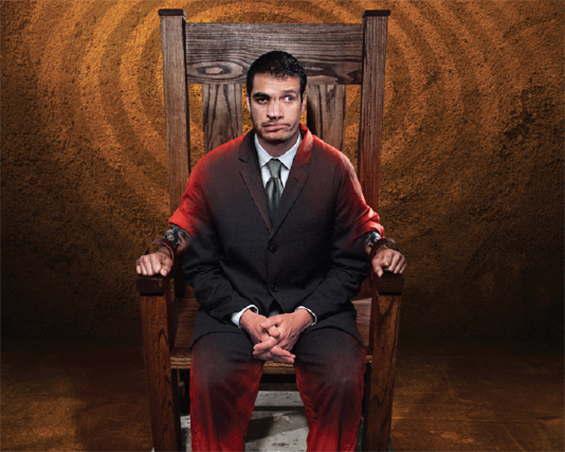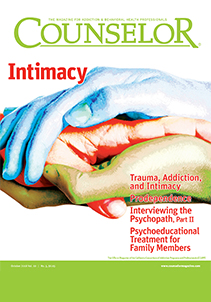Share

In part I of this article, published in the August 2018 issue of Counselor, we provided counselors with definitions, a brief overview, and key characteristics of psychopathy. In part II we will clarify the importance of understanding anxiety in psychopaths, provide case studies, and recommend therapeutic treatment options.
Anxiety
Anxiety can be helpful in both identifying the interconnectedness between anxiety and the aforementioned features of psychopathy and aiding in the understanding of psychopaths for diagnostic purposes. We will be explaining how discomfort—a mild to moderate form of anxiety—can be beneficial in diagnosing psychopaths. It should first be noted that research indicates differences exist between the importance of anxiety in children versus adults with psychopathy. According to Kubak and Salekin (2009), anxiety is positively associated with psychopathy in children and adolescents, but negatively associated or even unassociated with psychopathy in adults. Several case studies describing the connection between anxiety and adolescents will be provided in order to help ascertain a better understanding of its presentation for assessment purposes.
When the first author began working with the children at the Devereux Foundation in Devon, Pennsylvania in 1963, the clients displayed a broad spectrum of emotional disturbance and also experienced hurt, rejection, and anxiety to a vast degree. For example,
Joe, a sixteen-year-old male, was depressed about the divorce of his parents, the subsequent absence of his father, and the rejection by his mother. His mood was sullen and he remained withdrawn from our staff and his peers. Initial attempts to form a relationship with him were met with further withdrawal and a frozen posture. Any confrontation by his peers resulted in heightened anxiety and deepened depression as tears streamed down his cheeks. His face would become flush and his voice tremulous.
The anxiety caused by such emotional pain is unwanted, but it can be treated more successfully because of the nature of its pain. This type of anxiety, called subjective anxiety, stems from people’s awareness of their depression, their perceived roles in its cause, the resultant guilt, and the fear of continued emptiness that seems unavoidable (Chapman, 1976). Anxiety is one of the central concepts of interpersonal psychiatry. In 1954, Harry Stack Sullivan, pioneer of the interpersonal approach to psychiatry, employed this term in a special way; by “anxiety,” he meant virtually all the basic types of emotional suffering. This anxiety includes anxiousness, guilt, shame, dread, feelings of personal worthlessness, and other less definable painful feelings. Anxiety varies in degree from mild discomfort that is scarcely noticeable to disorganizing and incapacitating panic.
As Sullivan (1954) emphasized, the basic cause of anxiety is a strong threat to the emotional balance and well-being of people, which is a threat to their integrity. Such a threat is the result of emotional turmoil, both within people and in their relationships with others. This turmoil is caused by traumatic interpersonal relationships in both past and present life situations. As people sense that their emotional stability is being menaced, or even crumbling, they are flooded by profound feelings of dread and apprehension that we call “anxiety” (Chapman, 1976).
The symptoms associated with subjective anxiety in its severe form include increased heart activity, sweating, disturbed breathing, dizziness, apprehension, and feelings of impending doom. Obviously, this is a picture that anyone would want removed. Subjective anxiety is unwanted, frightening, and persistent. It creates pain and suffering for those afflicted.
Another cause of depression and subjective anxiety is in the notion of hidden guilt. Some children emerge from their childhood with profound inner turmoil caused by one or more traumatic events or unhealthy relationships that led to the formation of overwhelming guilt. They experience symptoms of anxiety, but have no idea about what may be the cause. They may evidence heart palpitations; cold, sweaty palms; hyperventilation; tremulous hands; facial muscular tension; and feelings of imminent death. However, these obvious signs of inner turmoil and severe outward distress actually make a more positive treatment possible.
Adolescents who are reprimanded by their teachers for misbehaving may experience insecurity, rejection, and distress from their perceived threats or may feel anger and dislike for the perceived criticisms. In any case, adolescents may become uneasy by their newly shaken security and the unknown consequences of their actions. It is within this new framework that anxiety flourishes.
Another cause of anxiety, one that is closely related to psychopathy, is evidenced by the following example:
The parents of a fourteen-year-old girl grounded her for not doing her homework, lying, and producing poor grades. The girl’s first response was anger and withdrawal from her family. However, because of some understanding but firm parental intervention, she began to express remorse and humiliation for doing so poorly and she acknowledged the reality of her responsibility. She expressed fear about the loss of her parents’ love. Her manifest anger and withdrawal was a defense against experiencing further rejection and guilt. When her parents talked to her about their love for her and demonstrated that they would not accept her misbehavior, the fourteen-year-old’s manifest guilt, anxiety, and fear of loss emerged.
Children who fail to experience subjective anxiety will rarely understand or appreciate family pain and the need for cooperation and change. These children feel only the pain of the moment, which lasts only as long as the conflict is paramount. As soon as the pressure is diminished, they resume their patterns of irresponsibility and indifference. Contrary to subjective anxiety and its positive prognosis for treatment, uncaring adolescents experience another kind of anxiety: objective anxiety. Uncaring people indeed experience anxiety, but it is “the anxiety of the moment” and it lasts only as long as the perceived threat is present. They may be awaiting a hearing for a legal infraction, wondering if their parents will discover their lying, or hiding their failing grades. This objective anxiety subsides as soon as the threat is gone. If anxiety lasts only for the moment and people are able to escape uncomfortable situations without regard or remorse for those whom they have hurt, we can quickly understand the difficulty in helping these individuals work on mediating and resolving interpersonal conflicts.
When we think about the behavioral and/or emotional problems of children, we become concerned with a multitude of issues: Are the parents properly caring for these children? Are they suffering emotional, physical, or sexual abuse? Are they depressed? However, how often do we consider the widespread emotional and physical abuse that children can perpetrate on their parents? To understand the immense suffering of the family, we must first recognize the parents’ and family members’ attempts to help uncaring children in spite of continued rejection, alienation, and abuse they experience at the hands of these children, all of which may be indicative of future psychopathy. This can be better understood by the following case examples of June and John. The third case example of Steve provides clinicians with insight into the destructive nature of criminal psychopathic tendencies, and the importance of appropriate identification for treatment, which is provided in the final section.
Case Examples
June
June was a seventeen-year-old whom her father described as a pathological liar. Other than detecting her lying behavior, her parents always saw her as warm and loving. However, they began questioning whether she really cared at all. They lost their trust in anything June said, and they also experienced a loss in their ability to love her as they had in the past. June revealed a significant piece of information that has become a cornerstone in assessing similar individuals.
The dialogue in Figure 1 illustrates this.

This dialogue is typical of children like June. They show disregard for values and principles and do not experience the anxiety that normally would be expected. The subsequent sessions with June were uneventful; she continued to view therapy as a “waste of time” while attempting to diminish her wrongdoing. Therapy then was directed to working with her parents. The task was the diminishing of the parents’ anxiety and the placement of the anxiety in the form of controlled discomfort onto June. The parents and therapists determine the degree of discomfort based on the particular needs of the children. Without June’s experience of discomfort, positive change could not be expected. When children are resistant to working through the problems that they cause, we find it more useful to direct attention to the parents. When parents have the tools to facilitate change in their children, more positive outcomes may be expected.
Dealing with June’s lack of concern or anxiety in any form was the focus of the therapeutic attention. After proposing a plan to make June responsible for her actions and consequences, the initial progress was noted. Progress was interrupted because June ran away with her boyfriend. Her parents continued to feel guilt and emotional pain due to their perceived failure. They blamed themselves for not being able to resolve June’s problems earlier.
June was neither bothered by this nor was she able to identify with any type of anxiety in spite of her parents’ confrontation. This missing link—discomfort, a mild to moderate form of anxiety—must be present before any meaningful behavioral changes can be made. Working on changing misbehavior should be started as early as it is noticed.
June’s characterological behaviors are examples of early psychopathic traits seen in later development. She lacked empathic regard for others, cared little for rules, and lacked any concern for the feelings of others, especially her parents. She could be considered a “budding psychopath.”
John
A school counselor referred thirteen-year-old John. John’s parents reported an array of problematic behaviors that began in the first grade. His current problems included disobeying teachers, instigating fights, walking out of class, using profanity, refusing to obey family rules or do chores, lacking concern for the rights of others, and making poor grades. John’s eleven-year-old brother was a good student who had no problems at home or school and who easily formed and maintained interpersonal relationships.
John’s parents worked middle-class jobs and adequately provided for all of their children’s emotional and material needs. Both parents came from healthy and caring parents with whom they maintained close relationships. There was nothing noteworthy in either parent’s past that would suggest family pathology. Both parents entered into marriage with the hopes of raising healthy children and providing them with all the love and guidance they could give, but they were not ready or prepared for what was to occur. The parents reported nothing unusual during John’s first six years of life. When he entered the first grade, however, they began getting reports from the teacher about his stubbornness, oppositional behavior, and inattentiveness. This scenario continued throughout elementary school. He was suspended four times for fighting, being disobedient, and cursing. His parents said that John was untrustworthy, aggressive, and a liar. He stole money from them, violated the rules at home, and had temper outbursts. When angry, he threw and broke things.
After repeated attempts to change John’s maladaptive behaviors, his parents engaged a mental health professional to counsel John and the family. The counselor insisted that the parents needed to be less restrictive and should allow their children to have more freedom for self-expression. He encouraged reflective listening techniques and I-messages so that they might win his cooperation. After three months of therapy, the family dropped out of treatment because they saw no meaningful change in his behavior.
Two more attempts at therapy were also unsuccessful. School personnel regularly contacted John’s parents about his repeated problematic behavior. John’s mother had to make excuses to her boss so that she could leave work to deal with her son’s troubles at school. As the problems continued without resolution, a rift between the parents began to widen due to the perceived softening or hardening of discipline by either parent. As John’s behavior became the predominant focus of daily attention, the atmosphere in the home became cold and unfriendly. His brother became more isolated and absent in family matters. Due to John’s rude and uncaring attitude, the maternal grandparents experienced additional emotional pain when they came for a visit during a two-week vacation.
The family was in severe conflict and experienced significant pain, loss, frustration, and disillusionment. John’s uncaring and indifferent attitude toward their despair further aggravated an already miserable and decaying situation. Nevertheless, they continued to make every effort to reach him and make him feel their pain. Unfortunately, their attempts were in vain. In fact, their repeated and fruitless attempts not only caused further turmoil and despair, but also reinforced their powerlessness to an already power-mad John. He remained fully in charge of the emotional health of the family. In spite of John’s continued alienation from his relatives, his parents repeatedly but futilely expended emotional and physical energy to get him to behave in a caring and unselfish manner.
Discussion
To understand the nature and extent of these horrifying problems, we must recognize the conditions that apparently foster and nurture their existence and perpetuation. To illustrate this, let us look at the case of one thirteen-year-old female patient who did not arrive at home from school at her scheduled time. Her frantic parents spent the next two hours calling the school, neighbors, and her friends. Finally, they received a phone call from their babysitter, who was several miles from their home and informed them that their daughter was with her. The child told them that she had been held down by several boys on the bus and was prevented from exiting. However, her friends revealed that the child missed her stop because she had been playing and “cutting up” with her girlfriends and several boys. Upon confrontation, she denied what her friends had reported and began to make further accusations about their characters. It was not until her best friend and her parents confronted the child that she broke down and admitted her action. However, even after her admission, she accused her parents, friends, and schoolmates of hating her. She held fast to a tale of never being cared about or loved.
This example describes two major defense mechanisms at work: The child denied any wrongdoing or responsibility for her actions and then projected the blame on others when denial was unsuccessful. These defenses are usually present when uncaring children are faced with anxiety-producing situations, and are often indicators of early signs of psychopathy. Because anxiety (even in its mild form) is painful and unwanted, uncaring children will maintain and nurture any position necessary to avoid it, even at the expense and emotional cost to their families. If parents have knowledge of the early warning signs of uncaring child syndrome and have the skills that are necessary to deal with it when their children are young, there might be more positive outcomes.
The true psychopath certainly feels objective anxiety. This type of anxiety warrants concern within the therapeutic realm, as early intervention—especially in children—can lead to more positive outcomes.
After the final case example of Steve is delineated to identify the importance of proper training and assessment of psychopaths, the therapeutic focus and aforementioned outcomes used for both children and adults will be identified in the treatment section.
Steve
Psychopaths can be the most deceptive and manipulative types of criminals. What makes them so difficult to identify is that they wear a very convincing mask of sanity. However, even when identified as such, they may have learned how to “beat the system.” We recall such an individual—Steve—who had been referred to a mental health professional after being sent to juvenile detention because of a history of killing animals, compulsive lying, stealing, and a host of other antisocial behaviors. It was reported by his parents and teachers that Steve never evidenced guilt or remorse from any of his actions in spite of the harm that resulted from his behaviors. Once incarcerated, he was provided with mental health counseling for several months. After receiving counseling and being interviewed by a psychologist, it was noted that Steve gained insight and positive growth from said counseling. The psychologist agreed that counseling had ameliorated his condition and concluded that he highly benefited from mental health intervention. A short time after being released, Steve was arrested after burglarizing a store. The storeowner was hit on the head with the butt end of a shotgun when he did not provide Steve with money.
This young perpetrator was interviewed in the jail by a mental health professional. Steve initially evidenced guilt and remorse for his crime, as reported by the mental health professional, but he was also heard saying to several of his inmate friends how he enjoyed hurting the storeowner. Additionally, it was discovered that Steve bragged that he planned to murder the storeowner because he failed to give Steve enough money. It was only because his crime was short-lived that he did not conclude this plan.
Further forensic mental health interviews evidenced greater detail of Steve’s true mental state. Additional collateral sources revealed a true nature that was not discovered by previous mental health evaluations. It was only due to the experience of the forensic mental health evaluator and his specific expertise in interviewing psychopaths that Steve’s true nature was revealed.
The following treatment recommendations can assist mental health clinicians, as it is clear through these case examples that specific knowledge is imperative when working with psychopaths.
Treatment
There has been considerable skepticism regarding the effectiveness of therapeutic interventions in relation to psychopathy, including the notion that therapy could exacerbate the already harmful condition (Chakhssi, de Ruiter, & Bernstein, 2010). According to Wilson and Tamatea (2013), as a result many clinicians have avoided the treatment of psychopaths. However, recent literature provides new support for various types of treatments using interventions most clinicians are well versed in providing. Thompson, Ramos, and Willett (2014) reported the key to providing this effective treatment is to focus on the dynamic, observable aspects of the disorder (i.e., the factor 2 items presented in the first article of this series). In contrast to focusing on factor 1 items (also presented in the first article), which are both inherent within psychopathic personalities and not amenable to treatment, clinicians can instead focus on the more dynamic factors such as impulsivity, irresponsibility, long-term goal planning, and anger management. Psychopaths who do present in the therapeutic realm often state that they feel there is nothing wrong with them, but continue to state that they have been receiving poor reports in their workplaces, are not able to complete tasks they start (like education), and are involved in failing marriages (Thompson et al., 2014). Most clinicians are proficient at dealing with one or all of these problems and will begin the collaborative process of goal setting with clients in order to relieve these challenges. The key is understanding the underlying pathology inherent in psychopaths—the pathology causing the aforementioned challenges—and remaining cognizant of this throughout the treatment process.
There have been several reported standards to treating psychopathy that have had positive results, both in achieving the therapeutic goals and reducing the harm psychopaths are doing in society. According to Furnham, Daoud, and Swami (2009), behavioral therapeutic interventions have shown promising results as long as therapists bear in mind the underlying pathology, which will result in some deficits in skills. However, goals can still be geared toward how to deal with authority, controlling anger, and improving communication, for example. Furthermore, Furnham et al. (2009) reported that cognitive-based therapies also show promise—though they tend to focus more on thought distortions or maladaptive thoughts that have led psychopaths down their destructive paths—and can teach clients using social imitation, thus utilizing a skill they have already acquired, but utilizing it in a way that leads them to more positive and nondestructive results. Finally, the treatment setting can utilize both group and individual sessions, with group sessions focusing on anger management and reactivity while individual sessions concentrate on cognitive distortions and social skills training using schema therapy (Chakhssi et al., 2010). Wise clinicians will monitor the group sessions carefully in order to identify if psychopaths are attempting to manipulate or coerce other clients, and if so can either address these behaviors or instead recommend more individual sessions.
The main idea is to first understand that certain characteristics must be identified and attended to during the assessment period. Clinicians must look for some of the key characteristics associated with psychopathy and be mindful to use the aforementioned techniques in order to gather more information as well as avoid teaching the rote responses. This will provide clinicians with a better understanding of the pathology of these kinds of clients. From there, and consistently bearing in mind the deficiency in skills, therapists can then move to identifying goals and choosing the most appropriate therapeutic intervention.
Conclusion
How can we trust people at face value? How do we know what we see and hear are being truly represented? Without knowing a plethora of facts about what is being stated, how can we know if what we are being presented is true or a merely a façade used to hide the fact that the people in front of us are psychopaths?
Many individuals present as a multitude of personality types who at first blush appear genuine, depressed, angry, or anxious, but then later are found to be in significant contrast to who they truly represent. How many individuals appear as the genuine article and then later are arrested for abusing their spouses? How many individuals present themselves in a favorable light, but when home with their family there is evidence they are unempathic, cold-hearted people? The truth is that there are many, especially within the prison system. Knowledgeable clinicians can educate themselves on the aforementioned characteristics and recommendations in order to be prepared to assess and treat psychopaths. Then, and only then, will psychopaths’ true natures come to light.
Gains in therapy with these patients are exceedingly slow and arduous. We see only microscopic improvements when working with these individuals. However, we must almost hope for despondency and depression to occur, since narcissism and grandiosity are the hallmarks of most psychopaths who seek exploitative ways of manipulating themselves out of unpleasant situations.
Patients who evidence psychopathic traits may come to sessions after therapy is well underway and verbalize such sentiments as “there is nothing for me to do.” When this moment occurs, therapists may repeat acknowledgments of the despair induced by the absence of manipulative abilities. Patients may act out even more than before the depression and anger directed towards their therapists occurred. Premature attempts to terminate the sessions and repeated absences of a manipulative nature often occur. When patients can visualize what can happen to them if they engage in socially deviant types of behaviors, they have shown progress in their treatment. If they can recognize anger, fear, and the dynamics of affective expression, they have made some improvement.
References
Chakhssi, F., de Ruiter, C., & Bernstein, D. (2010). Change during forensic treatment in psychopathic versus nonpsychopathic offenders. The Journal of Forensic Psychiatry & Psychology, 21(5), 660–82.
Chapman, A. H. (1976). Textbook of clinical psychiatry: An interpersonal approach. Philadelphia, PA: Lippincott Williams & Wilkins.
Furnham, A., Daoud, Y., & Swami, V. (2009). “How to spot a psychopath”: Lay theories of psychopathy. Social Psychiatry and Psychiatric Epidemiology, 44(6), 464–72.
Kubak, F. A., & Salekin, R. T. (2009). Psychopathy and anxiety in children and adolescents: New insights on developmental pathways to offending. Journal of Psychopathology and Behavioral Assessment, 31(4), 271–84.
Thompson, D. F., Ramos, C. L., & Willett, J. K. (2014). Psychopathy: Clinical features, developmental basis and therapeutic challenges. Journal of Clinical Pharmacy and Therapeutics, 39(5), 485–95.
Sullivan, H. S. (1954). The psychiatric interview. New York, NY: WW Norton & Company.
Wilson, N. J., & Tamatea, A. (2013). Challenging the ‘urban myth’ of psychopathy untreatability: The high-risk personality programme. Psychology, Crime & Law, 19(5–6), 493–510.
About Me
Norman E. Hoffman, PhD, EdD, LMHC, LMFT, was accepted to the clinical internship at Menninger Memorial Hospital after working in the psychiatric department at the Devereux Foundation. He studied at the Thomas A. Edison College, where he was awarded a doctor of philosophy in psychotherapy. In 1994 he completed a doctoral degree in human services counseling from the University of Sarasota, and in 1995 he obtained a doctor of pastoral psychology from Florida Religious University.
Valerie Watt, PhD, LCSW, is a psychotherapist who resides and practices in Ormond Beach, Florida. Dr. Watt moved to Florida from Syracuse, New York in 1983. She pursued her education and attained her doctorate in pastoral psychology in 1997. In addition to her private practice, Dr. Watt is the vice president of the National Board of Forensic Evaluators and serves as the chair on the oral examination committee to credential eligible candidates for certification as forensic mental health evaluators.













 Counselor Magazine is the official publication of the California Association of Addiction Programs and Professionals (CCAPP). Counselor offers online continuing education, article archives, subscription deals, and article submission guidelines. It has been serving the addiction field for more than thirty years.
Counselor Magazine is the official publication of the California Association of Addiction Programs and Professionals (CCAPP). Counselor offers online continuing education, article archives, subscription deals, and article submission guidelines. It has been serving the addiction field for more than thirty years.